Recent Articles
Popular Makes
Body Types
2018 Honda Ridgeline vs 2018 Toyota Tacoma: Which is Best?
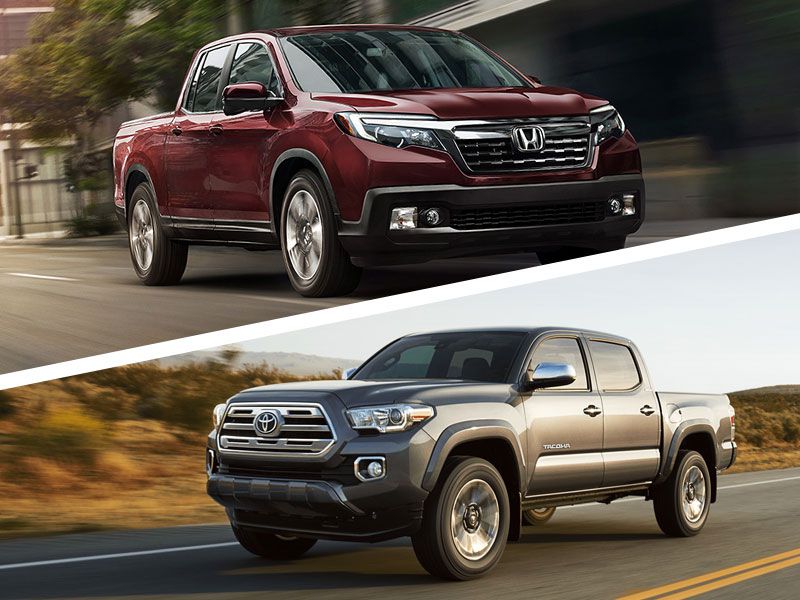
2018 Honda Ridgeline vs Toyota Tacoma ・ Photo by Honda / Toyota
Toyota outlasted most competitors in the shrinking compact/mid-size pickup truck market, and its Tacoma has been a best-seller for two decades. Meanwhile, the Honda Ridgeline has always been an outlier. In a class populated with body-on-frame vehicles, it won fans for its unibody construction in 2006 and other unique characteristics. An all-new Ridgeline returned for the 2017 model year, still built as a unibody — and still an outlier in many respects.
Two mid-size pickup trucks, each with a loyal following. That leaves one question to be answered: Which of the two is better, the 2018 Toyota Tacoma or 2018 Honda Ridgeline?
Design
Following an unconventional first generation that won few fans for its styling, today's Ridgeline looks much more conventional-looking pickup. Up to the back of the rear passenger doors, the Ridgeline is very similar to the Honda Pilot crossover, albeit with a unique grille treatment and a bit less ornamentation. The high bed walls are at the same height as the lower window sills, so the bed looks organic to the truck. While it still looks different from the pack, it fits in more with other pickups.
The Tacoma looks like it spent all of its free time in the gym with the free weights. Rather than attempting to emulate the work truck look of the Toyota Tundra and the other big boys, the Tacoma has beefed up with bulging fenders and wheel arches, a big hood, and an overall athletic look. There’s a visible gap between the cab and bed, an indication of its body-on-frame construction. Even though the gap has narrowed between the Ridgeline and Tacoma in terms of appearance, the Tacoma’s stance and assertiveness win in the end.
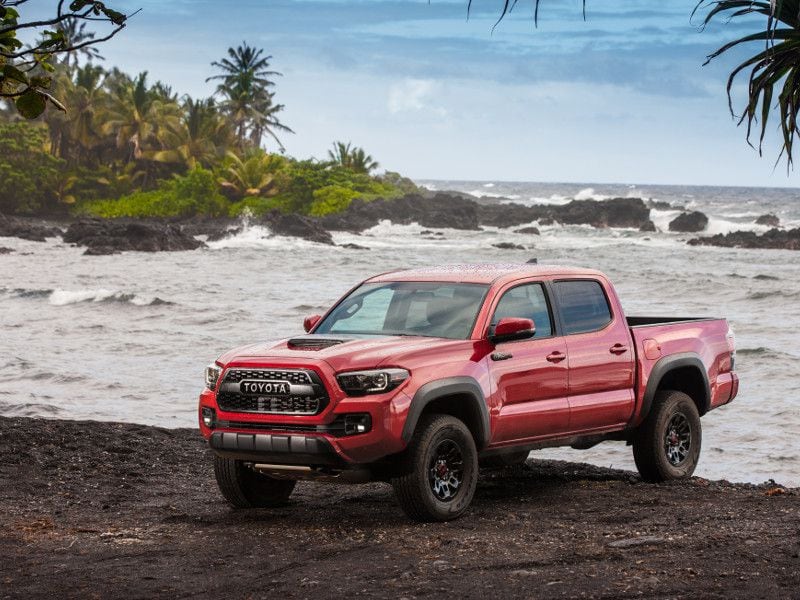
Photo by Toyota
Engine
Each Ridgeline comes with a 3.5-liter V6 with direct gasoline injection, four valves per cylinder with iVTEC, a drive-by-wire throttle, and variable cylinder management. With an aluminum-alloy engine block and cylinder head, it's tuned to deliver 280 horsepower and 262 lb-ft of torque.
The Tacoma offers two engine choices. The base engine is a 2.7-liter inline four-cylinder with a cast-iron block and aluminum-alloy head, electronic fuel injection, a mechanical throttle, four valves per cylinder, and VVT-I, producing 159 hp and 180 lb-ft of torque is standard on SR and SR5 models. A 3.5-liter V6 with direct gasoline injection, a mechanical throttle, four valves per cylinder, and VVT-iW and VVT-IW. The V6 cranks out 278 hp and 265 lb-ft of torque. By virtue of offering options, the Tacoma takes this category.
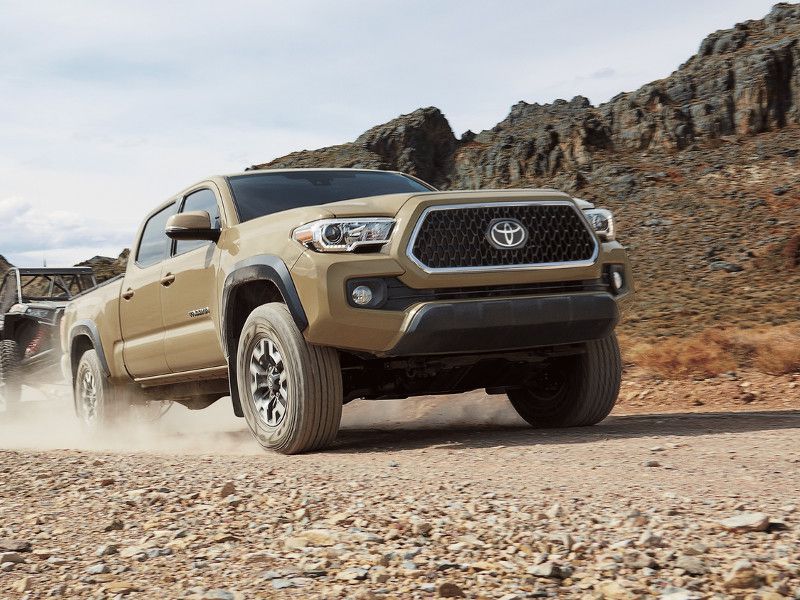
Photo by Toyota
Transmission/Drive Options
The Ridgeline comes with a six-speed automatic transmission and either front-wheel drive or all-wheel drive. The Tacoma comes with a six-speed automatic transmission and either rear-wheel drive or part-time four-wheel drive. A six-speed manual transmission is available on the TRD Sport and TRD Off-Road models.
Truck buyers have shown a marked preference for rear-wheel drive pickups, and the option of a manual transmission is a bonus — so we have to give the advantage to the Tacoma in this category.
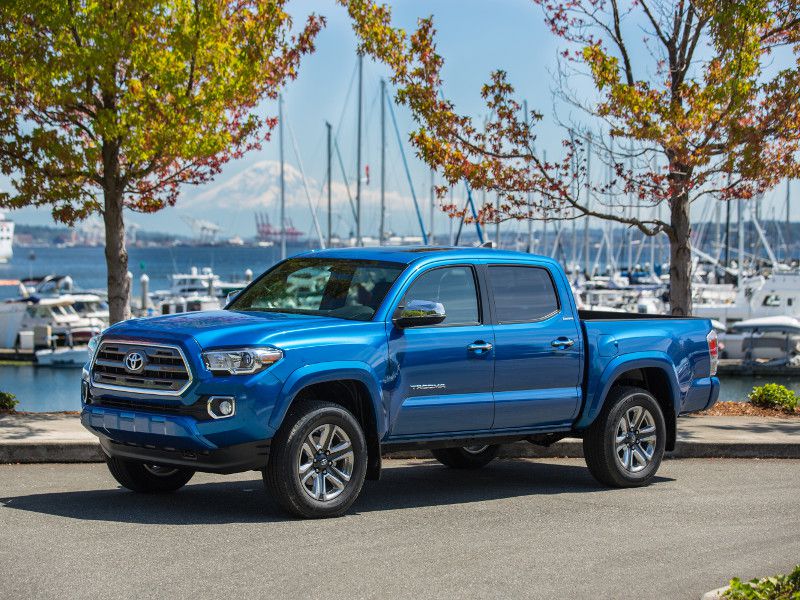
Photo by Toyota
Comfort/Amenities/Extras
Climb inside the Ridgeline’s cabin, and it’s easy to forget that you’re in a pickup truck. That’s because the front cabin is nearly identical to the Honda Pilot SUV — which is to say, pretty darn nice. The rear seat is roomy enough for three adults to sit comfortably, and the cushion easily flips up to accommodate cargo up to 4 feet tall on a flat load floor. Available features include three-zone climate control, power seats, heated front seats, leather upholstery, a power sunroof, a power-sliding rear window, and more.
The Tacoma’s interior is more rugged than the Ridgeline’s, with beefier controls, textures, and details. Dual-zone climate control is available, along with heated leather-trimmed seats. There are no power adjustments for the front seats, while the rear is a 60/40-split bench that folds up for cargo. A power-sliding rear window is standard on TRD Sport and higher trim levels, and it's manually operated on the SR and SR5.
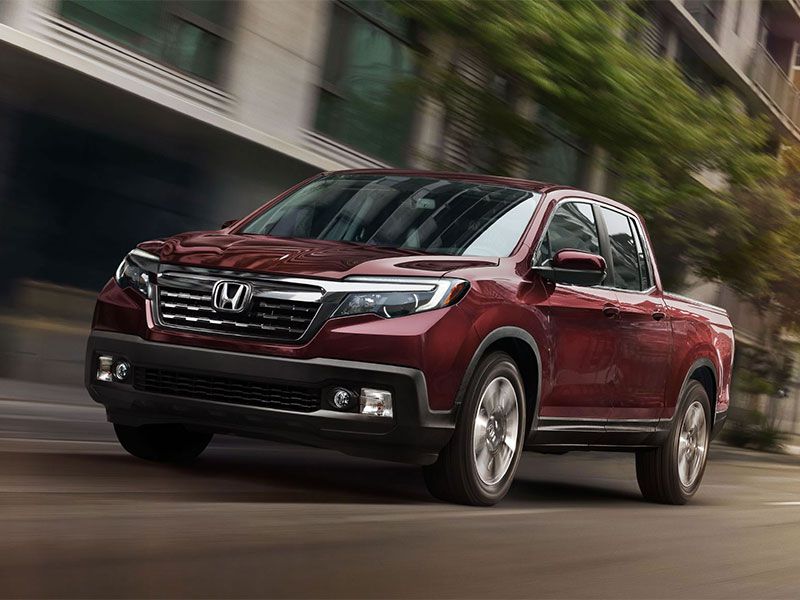
Photo by Honda
Hauling and Towing
In a traditional tale of the tape, the Tacoma with the available 6-foot bed wins with a longer interior bed length (73.7 inches) versus 64.0 inches for the Ridgeline. The Ridgeline’s minimum bed width is 50.0 inches at the wheel wells, while Tacoma’s is 41.5 inches. Each truck’s inner bed is built from sheet-molded composite, which won’t rust or dent. The Tacoma’s maximum payload ranges from 1,120 to 1,620 lbs (depending on configuration), and the Ridgeline’s ranges from 1,447 to 1,580. The Tacoma comes out as the leader on towing capacity, ranging from 3,500 to 6,800 lbs — superior to the Ridgeline’s limit of 3,500 with front-wheel drive and 5,000 with all-wheel drive.
The numbers don't tell the whole story, though. The Ridgeline has two killer standard features that tip the scales. One is a lockable under-bed storage compartment with 7.3 cubic feet of capacity, and the second is a "Dual-Action Tailgate" that opens in two directions.
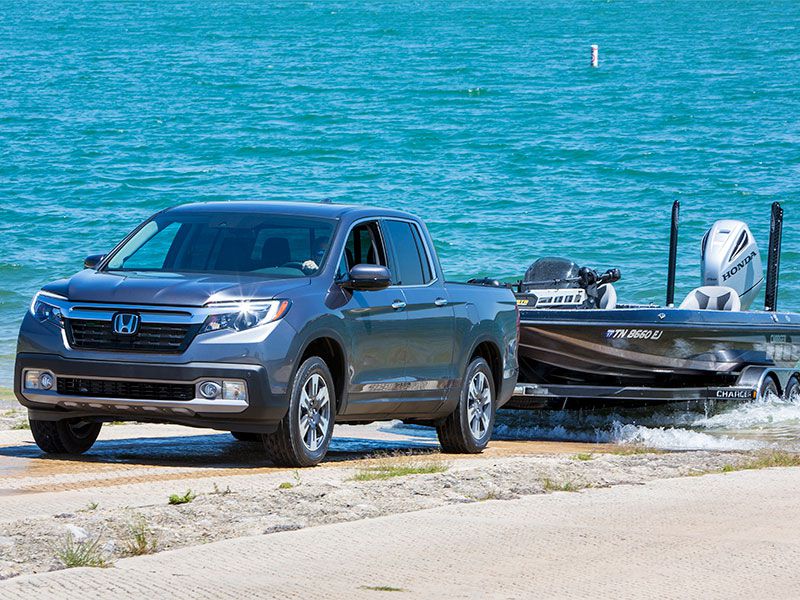
Photo by Honda
Infotainment/Technology
The Tacoma comes standard with Toyota’s Entune Audio, a very good connectivity suite that includes a 6.1-inch touchscreen display (7-inch on premium systems), a USB port, iPod connectivity and control, voice recognition, Bluetooth connectivity, Siri Eyes Free, and a backup camera. The SR5 includes Toyota's Connected Navigation app, while integrated navigation and a full app suite are standard on the TRD Sport and above. A premium JBL audio system is available with additional capabilities, six speakers, and a subwoofer.
The Ridgeline RT, Sport, and RTL have a 5-inch color LCD screen; a 200-watt audio system with seven speakers including a subwoofer; Bluetooth; and a backup camera. The RTL-T, RTL-E, and Black Edition have an 8-inch touchscreen, 225 watts (RTL-T) or 540 watts (RTL-E and Black Edition), Apple CarPlay, Android Audio, HondaLink, and more. Honda pushes it over the line with a first-ever available truck bed speaker system that uses the bed walls as speakers — a great gimmick that has to be seen and heard to be believed.
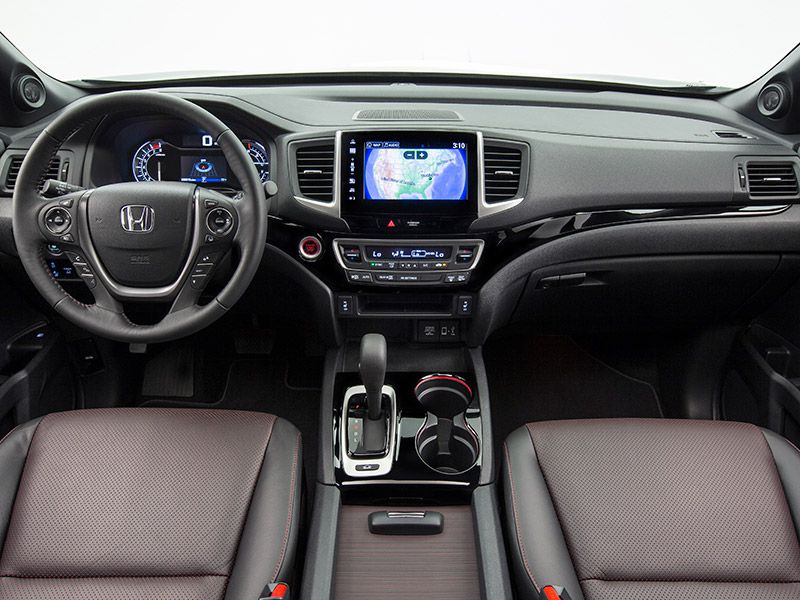
Photo by Honda
Safety
The Tacoma comes with a pre-collision system with pedestrian detection, a lane-departure alert with a sway warning, automatic high beams, and high-speed radar cruise control. Rear parking assist sonar is standard on the TRD Pro and Limited and available on SR5, TRD Sport, and TRD Off-Road trims. Blind-spot monitoring with a rear cross-traffic alert is standard on the TRD Pro and Limited and optional on the TRD Sport and TRD Off-Road.
The Ridgeline RTL-E and Black Edition models come with collision-mitigating braking, a road-departure mitigation system, a forward-collision warning, lane-keeping assistance, and a blind-spot monitor with a rear cross-traffic alert. The Ridgeline is also the only pickup to date to earn a Top Safety Pick+ designation from the Insurance Institute for Highway Safety.
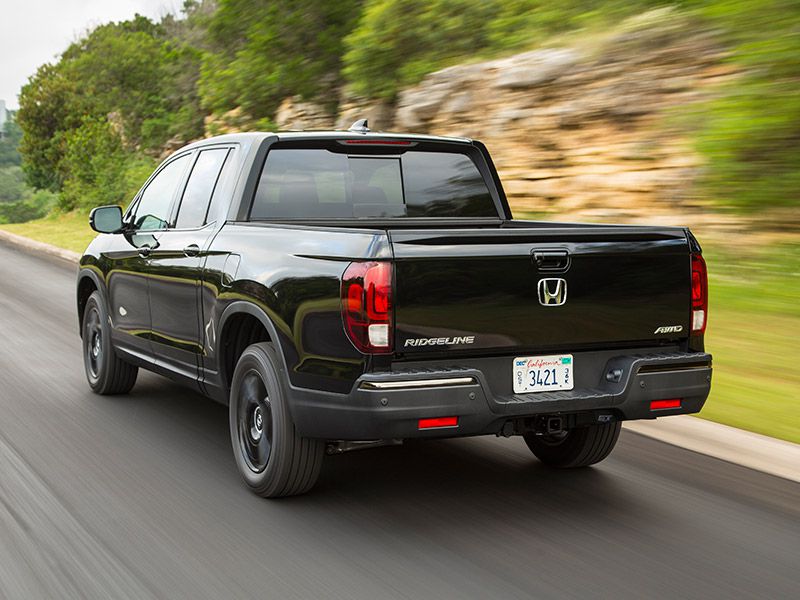
Photo by Honda
Driving Experience
The big difference between the Ridgeline and Tacoma is their rear suspensions. The Tacoma, like most pickups, uses rear leaf springs with shocks — in other words, a single axle connects the two rear wheels. The Ridgeline has an independent multi-link rear suspension and stabilizer bars in the front and rear. This difference makes the Ridgeline noticeably smoother and more composed on the road, delivering more “car-like” ride and handling characteristics — a bonus for drivers who use their pickup as a daily driver. The Ridgeline’s front-wheel drive bias makes itself known even in all-wheel drive models.
When the road ends and the dirt begins, the tables turn slightly. Toyota’s TRD division knows a thing or two about setting up a truck for adventure, and the Tacoma excels, especially the TRD Off-Road and TRD Pro models. Superior ground clearance (9.4 inches compared to the Ridgeline's 7.28 to 7.87 inches) and approach/breakover/departure angles mean the Tacoma can conquer obstacles and conditions that would leave the Ridgeline mired in the muck. Additional TRD and aftermarket accessories and parts can make the Tacoma into a dedicated off-road adventure vehicle.
Tie
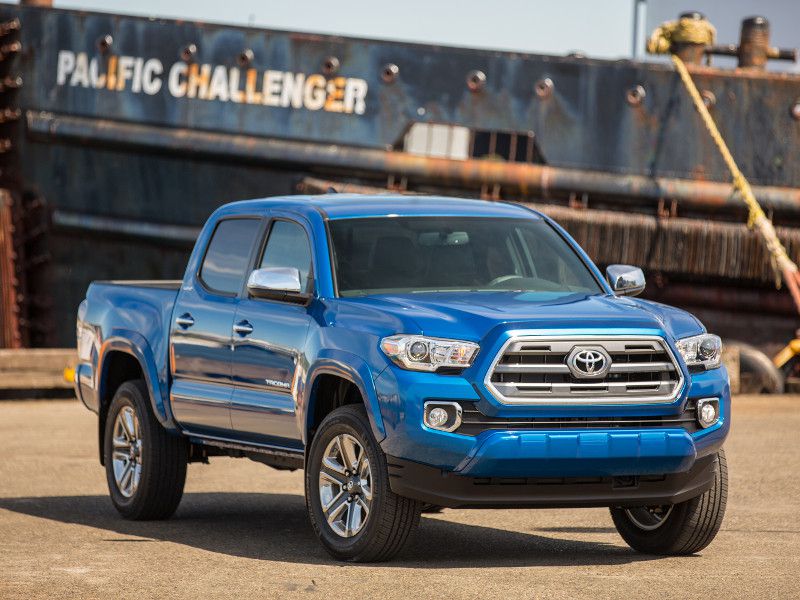
Photo by Toyota
Pricing
The Ridgeline is available in six trim levels: RT (starting at $29,990), Sport ($33,390), RTL ($34,870), RTL-T ($37,000), and Black Edition ($43,420). Front-wheel drive is standard on all trims except the RTL-E and Black Edition, which come only in all-wheel drive. Add all-wheel drive to the Sport, RTL, and RTL-T for $1,900. Every Ridgeline comes as a crew cab with four full-size doors, all with the same bed length.
The Tacoma is available in six trim levels: SR (starting at $25,400), SR5 ($27,175), TRD Sport ($32,095), TRD Off-Road ($33,350), Limited ($37,340), and TRD Pro ($43,720). Each trim can be ordered in 4x2 or 4x4 (for an extra $3,075) except the TRD Pro, which is 4x4 only. Extended cab models come only with the 6-foot bed, while most crew cab models come with a choice of 5-foot or 6-foot beds. Because of the wide range of choices and lower starting price, we give the nod to the Tacoma.
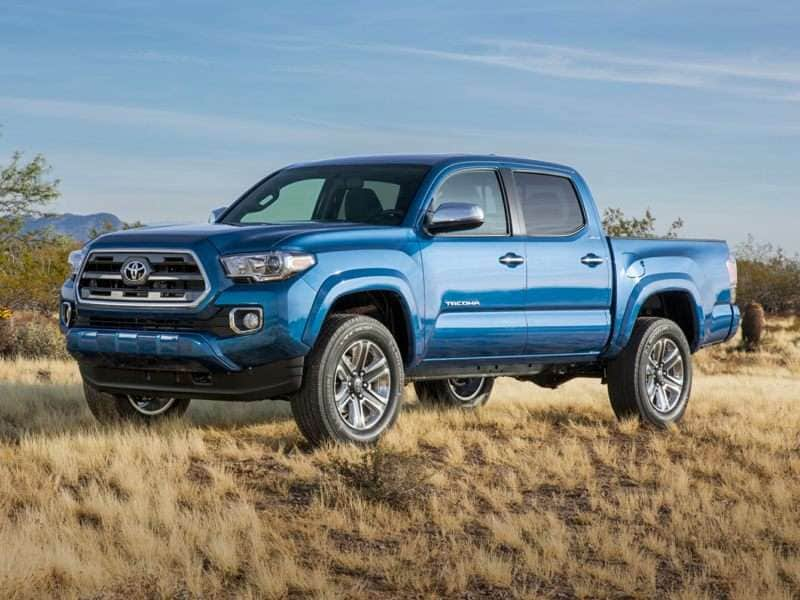
Photo by Toyota
Recommendations
So, which is better: the 2018 Honda Ridgeline or 2018 Toyota Tacoma? One might as well ask, “Which is better: chicken or steak?” Both offer nutrition, flavor, and endless culinary possibilities. The Ridgeline and Tacoma are both mid-size pickup trucks, but they each approach the genre from such different angles that the answer to the question depends more on the buyer than the product. If you need a dependable, capable mid-size truck, either will be a great choice. If money is a big factor, go for a Tacoma and select just the features that you absolutely need. If you spend a lot of time transporting friends and family, the Ridgeline might be a better choice, with superior amenities and a more SUV-like user-friendliness, especially for entry and exit.
Ultimately, though, despite Ridgeline’s unique features and greater level of polish, we’re going to have to declare Tacoma the better pickup truck — thanks to its adventure potential and all-around capability.
Toyota Tacoma
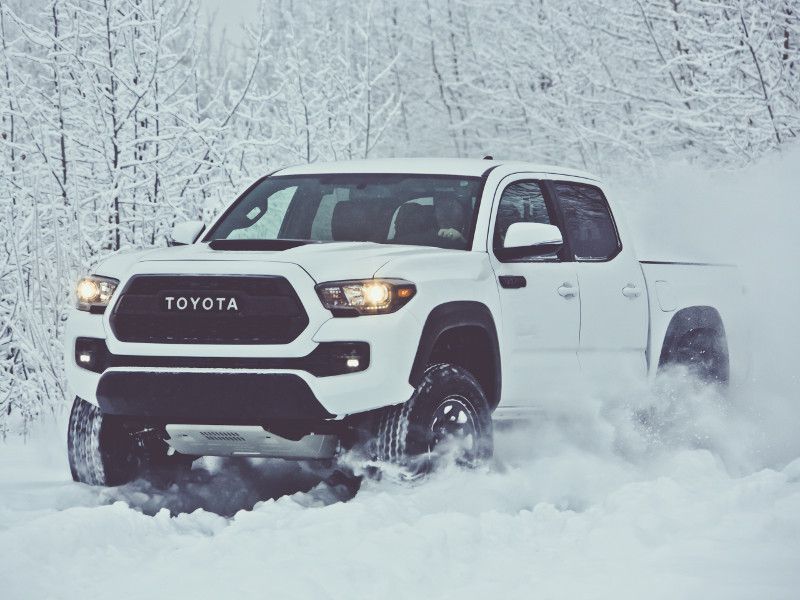
Photo by Toyota